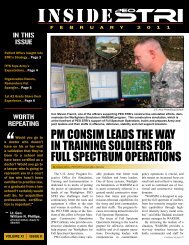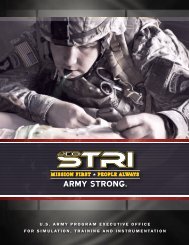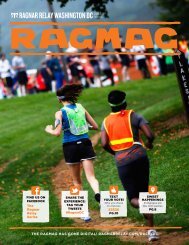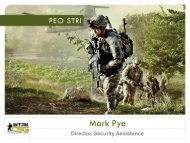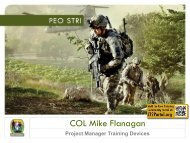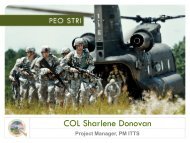InsideSTRI Jan-March 2013 - PEO STRI - U.S. Army
InsideSTRI Jan-March 2013 - PEO STRI - U.S. Army
InsideSTRI Jan-March 2013 - PEO STRI - U.S. Army
Create successful ePaper yourself
Turn your PDF publications into a flip-book with our unique Google optimized e-Paper software.
Soldiers from the 157th Infantry Brigade, First <strong>Army</strong> Division East train in the Dismounted Soldier Training System.<br />
Virtual Training Puts the ‘Real’ in Realistic Environment<br />
By Maj. Penny Zamora, 157th Infantry Brigade Public Affairs<br />
In a warehouse looking much like a laser tag<br />
game room, nine Soldiers gear up with flip down<br />
goggle mounts, sensors strapped to their arms<br />
and legs, and each carries a computer-enhanced<br />
weapon system. Just five years ago, this scenario<br />
may have only been seen in a video game. Today,<br />
virtual training environments are a reality.<br />
The Dismounted Soldier Training System,<br />
or DSTS, and Engagement Skills Trainer 2000<br />
are two virtual training tools that are quickly<br />
becoming the norm for Soldiers of the 157th<br />
Infantry Brigade, First <strong>Army</strong> Division East,<br />
in training deploying units at Camp Atterbury<br />
Joint Maneuver Training Center, Ind.<br />
“One of the best parts of the DSTS is we<br />
can create any operational environment, for<br />
our training in a virtual environment. It does<br />
not replace training, but it can add to it. We can<br />
bring the terrain of Afghanistan to the Soldier.<br />
It’s hard to imagine a mountainous terrain in<br />
Indiana, but the DSTS can create it,” said Sgt.<br />
1st Class Aaron Hammond, Operations, 157th<br />
Infantry Brigade, First <strong>Army</strong> Division East.<br />
Hammond and his team recently participated<br />
in a DSTS session to learn the capabilities offered<br />
at the Camp Atterbury Joint Maneuver Training<br />
Center virtual simulation centers. Geared up and<br />
ready to engage in a building entry exercise,<br />
the nine-man squad immediately encountered<br />
and reacted to enemy fire. With one member<br />
quickly disabled, the team had to quickly adjust<br />
tactics, techniques and procedures, and continue<br />
their mission.<br />
“Providing the most realistic and relevant<br />
training is the benchmark for success in First<br />
<strong>Army</strong> Division East when training Soldiers<br />
for worldwide deployments. Our job is to<br />
replicate situations in which the Soldier will<br />
face and to create an environment to rehearse<br />
repetitively at the squad or team level,” said<br />
Capt. Marcus Long, 157th Infantry Brigade<br />
training officer.<br />
Each Soldier stands on a four-foot diameter<br />
rubber pad. This pad is the center of a 10-<br />
foot by 10-foot training area for each squad<br />
member, and the pad ensures Soldiers remain in<br />
a specific area within the training suite. Soldiers<br />
can see and hear the virtual environment and<br />
also communicate with members of the squad<br />
using a helmet-mounted display with headphone/<br />
microphone set.<br />
“A Soldier uses his body to perform<br />
maneuvers, such as walking or throwing a hand<br />
grenade, by physically making those actions. The<br />
sensors capture the Soldier’s movements, and<br />
those movements are translated to control the<br />
Soldier’s avatar within the simulation,” explained<br />
Matthew Roell, DSTS operator.<br />
With a few computer commands, operators<br />
reset the virtual environment. This time the<br />
U.S. <strong>Army</strong> Photo<br />
squad encounters enemy fire and a mortar<br />
attack. The squad calls for and receives close air<br />
support and successfully negotiates the building<br />
entry task.<br />
“Each unit that comes through Camp<br />
Atterbury cannot receive close air support or<br />
call for artillery fire in live training, but we can<br />
create any simulated operational environment,<br />
desert or jungle, with any weapons system and<br />
any number of enemy forces with a few key<br />
strokes,” said Brandon Roell, DSTS technician.<br />
“This simulated training is the future of<br />
training. The DSTS allows a Soldier to wear<br />
the simulation instead of sitting inside of a<br />
simulator,” said Roell.<br />
As with any exercise, the after-action<br />
review, or AAR, is a critical step in helping<br />
units identify strengths and weaknesses. The<br />
DSTS provides a complete digital playback<br />
of a scenario from several vantage points.<br />
The operator can switch the playback from<br />
a third person view or worldview. During<br />
the AAR, First <strong>Army</strong> Division East trainer/<br />
mentors use the different views to illustrate<br />
specific actions.<br />
“Looking at each type of view, leaders can<br />
evaluate individual movement and actions, as<br />
well as the group as a whole. We cannot get<br />
this in-depth and multifaceted view during an<br />
Continued on page 11<br />
Inside <strong>STRI</strong> <strong>Jan</strong>uary/february <strong>2013</strong><br />
9



